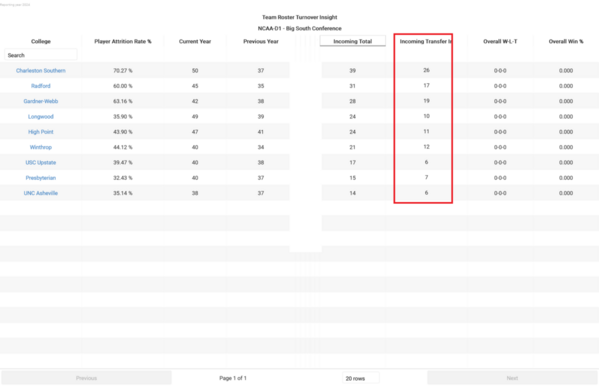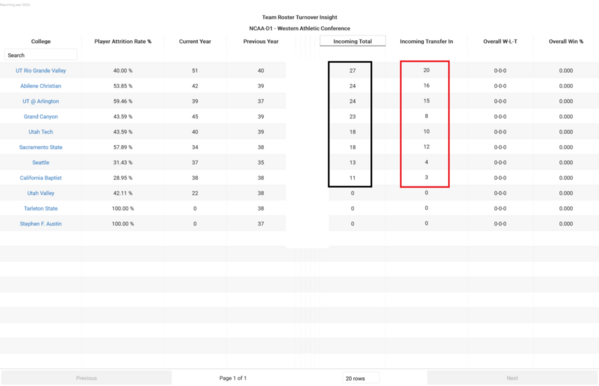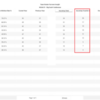Is the transfer portal reducing the amount of kids moving on to play college baseball? And I’m not saying this is a bad thing, or a good thing. But is the transfer portal weeding out those kids that probably shouldn’t be playing? I’ll, be interested to see the number of kids moving on to play in college over the next few years compared to before the portal was allowed. Are the numbers the same? Worse or more? And what’s the goal of the NCAA? To get more kids involved or to only promote the best? Or do they even care?
Replies sorted oldest to newest
Just posted this on the 4-schools thread, but it applies here, too.
The sit-out-a-year rule was only put in place in 2008; before that, players could transfer without sitting out a year, and transferring was rampant. The sit rule was intended to reduce transfers and, in particular, to increase the number of players who actually graduated. Check out some of the HSBBW discussions about how the sit rule was going to change everything:
@Dadof3 posted:Is the transfer portal reducing the amount of kids moving on to play college baseball?
I think it's making it harder, and shifting kids down, and then probably forcing out the kids in HS who were on the fringe.
The P5s are a different story. They probably should be a league of their own. And, I don't think it's changed that much for the mid-majors. But, for the lower end D1s, and the D2s, and D3s, the ability to get older and more experienced players through the portal impacts their HS recruiting needs. It's a small sample size and I live in a state with few D1 programs, but, I see a lot of kids who had D1 dreams going the D3 route by me now. And, to be candid, some of these D3 programs have fields and facilities comparable to the lowest D1 schools. I saw a D1 field this fall that wasn't even as good as some high end HS fields that my son has played on.
I haven’t seen any numbers to validate what is occurring. But transfer, don’t sit existed when my now 35yo daughter played college softball. On a year to year basis the number of kids desiring to play college ball isn’t changing. Transferring doesn’t shut players out. The portal is affecting roster stability. A less talented, marginal kid who gets discarded might decide he’s had enough rather than transfer.
My son played when players had to sit a year when transferring. He won a starting position mid season freshman year. He returned soph year to find a JuCo All American at his position. He wasn’t forewarned this was occurring before hitting campus in the fall. The coach told him chances are he will play somewhere. He did. He was an athletic, seven position prospect.
What did affect the numbers was when D1 rosters were limited to 35 players. This is when more players were pushed down a level.
At the D3 level there are plenty of colleges who will take as many players as will pay to attend the school. I know a kid who didn’t start at a small classification high school and was rostered for four years at a mediocre D3 program. For a few years his father puffed out his chest saying his kid played college ball while letting people assume it was the level they saw on tv.
Three factors caused the mess we currently have
1. MLB draft going from 40 to 5. Then 40 to 20.
- College junior offered 60k to sign in round 27? Good bye
- HS kid in a low income household with his parents wondering how they're going to afford the other 50% of tuition the scholarship doesn't cover? 225k in Rd 31 looks like a lot of money.
2. Covid year extra eligibility
3. Penalty free transfers
The covid year players will be phasing out in the next year or two, so that will correct itself. What will take a few more years to correct itself is the kids who redshirted because the covid year players came back and retained their roles. Five years maybe before it evens out. That being said, things were not great before covid.
That leads us to the transfer players. I personally don't think you should be able to transfer in conference, perhaps that would fix some of it, but either way it's still rampant. Now there are the haves and the have nots. Those who have poach, those who do not have their studs poached. Simple as that. What it has done is shrunk HS recruiting classes for the poachers.
5 years ago if you went to a D1 school and weren't getting a crack, you were replaced by a high schooler who had to deal with the same learning curve you did. Now you get replaced by someone who already hit .380 with 16 home runs at the collegiate level.
I think it works out better for HS players. Before, schools took everyone and said goodbye to those who couldn't hang. Not that it doesn't happen anymore, but there are less mistakes happening out of HS. Once you're on campus you're more easily replaceable than ever.
Long story short - Good for HS players. Bad for rostered players. Everybody has been pushed down a level. The biggest winners have been D2/D3 baseball who now have players who would have probably found themselves on a D1 roster 4 years ago.
If roster sizes stay the same, there will be no weed out because the coaches will fill those rosters. I think it’s a good thing like PABaseball states.
@PABaseball posted:Long story short - Good for HS players. Bad for rostered players. Everybody has been pushed down a level. The biggest winners have been D2/D3 baseball who now have players who would have probably found themselves on a D1 roster 4 years ago.
I feel like it does weed out some. Most likely, It forces families to make decisions about the long term instead of the short term. It has for me and I think about it a good amount. I think about baseball in terms of leverage to get into a better school rather than playing D1. I have an academically gifted player. He’s also a pretty solid LHP. So I’m not sure how I feel about chasing a baseball dream unless that dream flows through a HA or great school. So actually, maybe it doesn’t weed kids out, it just pushes everyone down a level like was said. 😁.
I hate when I finish a reply and feel like I should just delete it because I totally agreed with the previous post. 🤣🤣
@TexasLefty posted:If roster sizes stay the same, there will be no weed out because the coaches will fill those rosters. I think it’s a good thing like PABaseball states.
I feel like it does weed out some. Most likely, It forces families to make decisions about the long term instead of the short term. It has for me and I think about it a good amount. I think about baseball in terms of leverage to get into a better school rather than playing D1. I have an academically gifted player. He’s also a pretty solid LHP. So I’m not sure how I feel about chasing a baseball dream unless that dream flows through a HA or great school. So actually, maybe it doesn’t weed kids out, it just pushes everyone down a level like was said. 😁.
I hate when I finish a reply and feel like I should just delete it because I totally agreed with the previous post. 🤣🤣
Good article
RECRUITING ESSENTIALS: AFTER A MONTH, HOW ARE THE NEW NCAA RECRUITING RULES CHANGING THE LANDSCAPE?
@PABaseball posted:5 years ago if you went to a D1 school and weren't getting a crack, you were replaced by a high schooler who had to deal with the same learning curve you did. Now you get replaced by someone who already hit .380 with 16 home runs at the collegiate level.
I think it works out better for HS players. Before, schools took everyone and said goodbye to those who couldn't hang. Not that it doesn't happen anymore, but there are less mistakes happening out of HS. Once you're on campus you're more easily replaceable than ever.
Long story short - Good for HS players. Bad for rostered players. Everybody has been pushed down a level. The biggest winners have been D2/D3 baseball who now have players who would have probably found themselves on a D1 roster 4 years ago.
It will depend on the Head Coaches gameplan.
HC in 1st or 2nd yr are looking for immediate impact.
1st year coaches are stuck with the recruiting class of the previous coach, thus at the time of signing their contract they are looking at the portal for players that have already been involved in the college grind.
Below are a few conferences (2023 Fall) that shows total incoming vs transfers (4 yr or 2 yr)
The following link will provide some information on a limited view
Attachments
@CollegebaseballInsights posted:
Really enjoyed that article. Thanks!
@CollegebaseballInsights posted:It will depend on the Head Coaches gameplan. HC in 1st or 2nd yr are looking for immediate impact.
1st year coaches are stuck with the recruiting class of the previous coach, thus at the time of signing their contract they are looking at the portal for players that have already been involved in the college grind.
Well yes. But the programs that may not have been so transfer heavy prior to 2020 seem to be picking up multiple kids every year. Schools that may have had little movement are now taking 5-8 kids out of the portal every year.
Regardless of any gameplan, based on the comments made on this board, the news I read and the college kids and programs I'm around the general theme seems to be more kids are transferring and less HS kids are getting picked up.
Prior to covid a RHP throwing 88 was going to get varying levels of D1 interest depending on size/frame. Now that same kid is looking exclusively at lower level D1 schools and most of the love is coming from Jucos/D3s. Did the talent pool get that much better or can coaches jump in the portal and grab their established arms?
The mid-lower level D1s are serving as farm systems. They are taking the brunt of it. The beneficiaries seem to be the higher level D1 programs and the D2/D3s schools who are getting a kid who maybe 3 years ago would have committed to a competitive D1.
@PABaseball posted:Well yes. But the programs that may not have been so transfer heavy prior to 2020 seem to be picking up multiple kids every year. Schools that may have had little movement are now taking 5-8 kids out of the portal every year.
Regardless of any gameplan, based on the comments made on this board, the news I read and the college kids and programs I'm around the general theme seems to be more kids are transferring and less HS kids are getting picked up.
Prior to covid a RHP throwing 88 was going to get varying levels of D1 interest depending on size/frame. Now that same kid is looking exclusively at lower level D1 schools and most of the love is coming from Jucos/D3s. Did the talent pool get that much better or can coaches jump in the portal and grab their established arms?
The mid-lower level D1s are serving as farm systems. They are taking the brunt of it. The beneficiaries seem to be the higher level D1 programs and the D2/D3s schools who are getting a kid who maybe 3 years ago would have committed to a competitive D1.
Note, pre-covid is a thing of the past, thus it is best to talk about gameplan post covid.
Walter Beede's book "The Shift" outlines what was going to happen.
@PABaseball posted:Regardless of any gameplan, based on the comments made on this board, the news I read and the college kids and programs I'm around the general theme seems to be more kids are transferring and less HS kids are getting picked up.
Prior to covid a RHP throwing 88 was going to get varying levels of D1 interest depending on size/frame. Now that same kid is looking exclusively at lower level D1 schools and most of the love is coming from Jucos/D3s. Did the talent pool get that much better or can coaches jump in the portal and grab their established arms?
The mid-lower level D1s are serving as farm systems. They are taking the brunt of it. The beneficiaries seem to be the higher level D1 programs and the D2/D3s schools who are getting a kid who maybe 3 years ago would have committed to a competitive D1.
So, I guess that was my point/question. I think this could be good because you are weeding out the lesser talented kids. Is that a good thing or bad? I would think good, because I would think that would make the programs better, but worse if you are a borderline kid.




